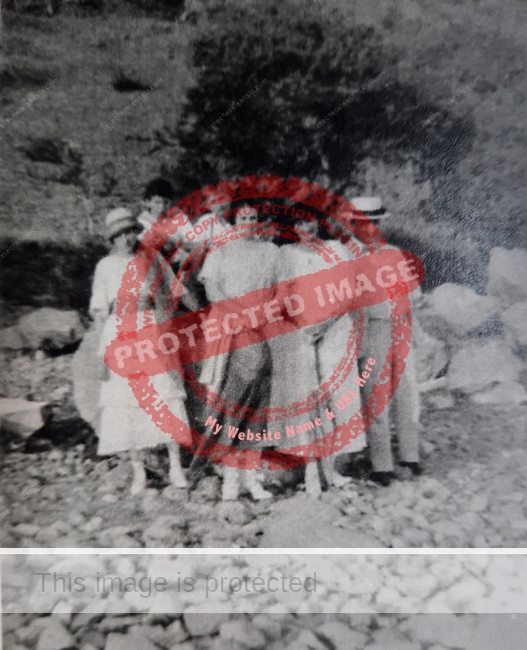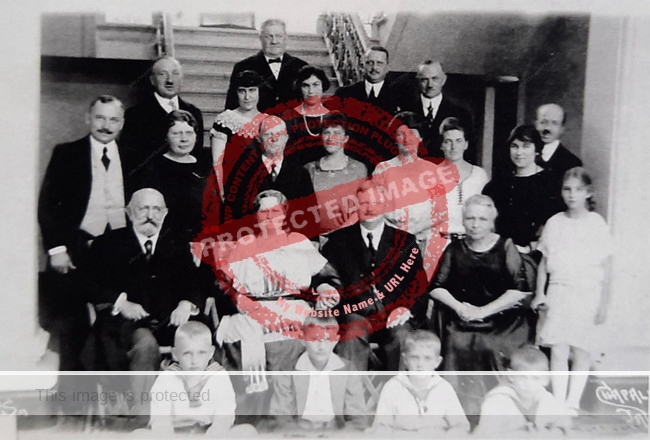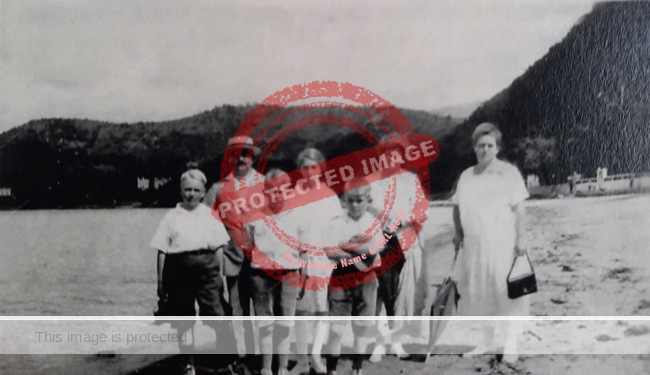Bertha Kaiser was the third wife of Swiss printer and shopkeeper Juan Kaiser, who—in addition to selling accounting books and ledgers via his store “Al Libro de Caja” in Guadalajara—also published beautiful early postcards of Chapala and Guadalajara featuring the work of such distinguished photographers as José María Lupercio and Winfield Scott.

Bertha’s diary, written in German in the first quarter of the twentieth century, was unknown outside her immediate family until relatively recently. Excerpts of the diary were published in 2012 as Tagebuch Von Bertha Kaiser-Peter Fur Ihren sohn Hans Paul Kaiser.
The diary contains frequent references to the members of the small Swiss community in Guadalajara, most of whom had close friendships and ties to the much larger German community in the city.
While the diary is mostly about the family’s experiences in Guadalajara and an extended trip to the US (via train to Manzanillo and steamer to California), there are some significant Chapala links scattered through it.
The excerpts begin in mid-1912 when Bertha and Juan’s son, Hans-Paul, was born in Guadalajara. Following his baptism, a celebration for family and friends was held at the Hotel Cosmopolita, before the Kaisers returned to their home in Jardines Seattle.
The Hotel Cosmopolita had been owned until a few years previously by German-born Francisco Fredenhagen (1849-1932), a close friend of the Kaisers, who, in about 1900, built one of the earliest weekend ‘cottages’ in Chapala at (or very near) the property which now has the address of Avenida Hidalgo #260.
Fredenhagen was a partner in a Mexico City brewery (“La Compañia Cervecera Limitada”) when he bought the Hotel Cosmopolita in 1885 and moved to Guadalajara. One of Fredenhagen’s grandchildren later married into the Seimandi family, which included one of the early managers of Chapala’s emblematic hotel—the Hotel Arzapalo—which opened in 1898. This marriage was very much in the tradition of the time that influential families consolidated their status and wealth through intermarriage.
In the mid 1890s, Fredenhagen drew anthropologist Frederick Starr’s attention to the many little pottery objects found in and around Lake Chapala, about which Starr subsequently wrote a short monograph. Fredenhagen also informed Starr about a “dwarf race” living in the hills near Ajijic, which the anthropologist planned to investigate with the assistance of Archbishop Gillow. Gillow is a particularly interesting figure in Mexican history; his story is told in Mexican Kaleidoscope: myths, mysteries and mystique.
After Fredenhagen sold the Hotel Cosmopolita in 1909, he announced plans to move to Chapala where he and his wife owned a cottage, before retiring to Germany. Events in Europe apparently caused them to rethink that idea; Fredenhagen died in Guadalajara in 1932, and his wife died there eight years later.

Members of Kaiser family in Chapala. Reproduced by kind permission of Verena Kaiser-Ernst.
Bertha’s diary records a visit to stay with the Fredenhagens in Chapala in April 1915. Paraphrasing Bertha’s text, on February 17th the family celebrated Juan’s birthday quietly at home. Juan was not feeling well (he had a chronic illness), and they were invited to visit the Fredenhagens at Lake Chapala. They left Guadalajara on April 15th in a privately hired stagecoach (diligencia), pulled by “five lively mules” over the “sometimes very bumpy roads.” It took seven hours, but “the beautiful journey” was a “reminder of how people made long journeys in stagecoaches before the coming of the railroad.”
They spent a month with the Fredenhagen family. Bertha and Juan took a pleasant walk in the mountains every morning, before having a swim, a leisurely lunch and a siesta. They took a row boat out in the late afternoon. After dinner, they entertained themselves playing jazz.
Hans-Paul (“Juanito”) and his nanny also had a good time at Chapala. Juanito played every day on the sandy beach, bathed, and loved his time in Chapala, especially after one of his Guadalajara friends arrived with her parents.

Group at Casa Nigg, Chapala, August 1922. Reproduced by kind permission of Verena Kaiser-Ernst.
Bertha recognized that Chapala was facing a difficult time. While the lake and its shores were as beautiful as ever, the unrest in the country had led to everything being neglected: “The beautiful private villas are mostly uninhabited, the hotels are poorly maintained. In former quiet times people flocked to Chapala from everywhere.” When the trip came to an end, they returned to Guadalajara by stagecoach, “taking the most beautiful memories home with us. Mr. & Mrs. Fredenhagen were such dear hosts.”
In the summer of 1915, the Kaisers undertook an arduous journey to California to combine having a family holiday with seeking specialist medical advice.
“It was a terrible journey to Colima…. It is one of the most dangerous routes in the world, wonderfully romantic in quiet times, but in revolutionary times the line was usually out of order, the trains in terrible condition, it was a horrible ride and ridiculed any description.”
Manzanillo was even worse: “The heat was unbearable, the mosquitoes plagued the children, particularly, day & night, bad food, nothing to drink.” About 40 people from Guadalajara were waiting in the port for the steamer “Peru” to San Francisco. After several days, the steamer finally arrived and the nine day journey to San Francisco was underway.
Bertha’s diary covers their California trip in considerable detail, including Juan’s chance meeting at a German music festival in Los Angeles with a fellow postcard publisher, “Mr Ruhland, an old friend whom he hadn’t seen in 12 years.” Emil Ruhland and his partner, Max Ahlschier, founded Ruhland & Ahlschier, the first company in Mexico permitted to publish and market illustrated postcards, in 1897. After selling the company in about 1903, Ruhland had moved to the US.
The Kaisers’ return home to Guadalajara is also described in great detail in Bertha’s diary. From Manzanillo, the “extra train” which arrived to take them to Guadalajara, “didn’t have passenger wagons but only freight wagons. Awful was the ride on this old railroad train that was fueled by wood… [with] the biggest rain of sparks, which was especially bad for the eyes when going fast.” To add insult to injury, Juan’s personal suitcase, containing clothes, cash and business notes, was stolen.
The dangerous stretch between Colima and Guadalajara lasted two days and a night. All too visible in the barranca below at one point were the wrecked locomotives and passenger cars from a train accident in which hundreds of people had died.
Unfortunately, Juan never recovered from his illness and died early the following year (1916). Given the uncertain future for the business, most employees resigned. Fortunately, with the assistance of a business administrator, Emil Keller, the company remained in operation while Bertha negotiated its sale to Juan’s brother, Arnoldo.
The following year, Keller asked Bertha to marry him. Bertha, greatly conflicted but wanting the best for her 5-year-old son, said ‘Yes” and the couple were married in a small civil ceremony at Bertha’s home on 24 October 1917. The newly weds left Juanito with his nanny, and drove to Chapala for a two week honeymoon.
After a week of wondering every day how Juanito was doing, “my husband decided to go back to Guadalajara and bring the little one to me as a surprise, which of course made me very happy… Now we could stay peacefully another week and enjoy the beautiful place.”
Bertha and her husband became accustomed to spending part of every summer in Chapala. Several photos in the diary provide glimpses into the social life of Bertha and her friends. In 1922, for example, Bertha was at the farewell party for the retiring Swiss consul, Juan Nigg. Nigg invited the entire Swiss community for a steamer ride on the lake and lunch at his lakeside home (Villa Francia). (Nigg’s successor as consul was Dr Sutter, director of the Faculty of Medicine at the Autonomous University of Guadalajara, who also had a home in Chapala.)

Silver wedding of Sres Jochimsen, Chapala, November 1922. Photo by José Edmundo Sánchez. Reproduced by kind permission of Verena Kaiser-Ernst.
In that same year, Bertha and Emil attended the silver wedding celebration in Chapala of Mr and Mrs Jochimsen. The group photo showing the invitees was taken by Chapala-born photographer José Edmundo Sánchez, whose postcards of Chapala are an invaluable source of social history.
The diary also includes this photo of the Lehmann family posing on the beach at Chapala.

The Lehmann family at Chapala. c 1925. Reproduced by kind permission of Verena Kaiser-Ernst.
Not long after the period described in the diary, Bertha and her family left Guadalajara to live in Switzerland.
Acknowledgment
My sincere thanks to Hans-Martin Kaiser and Verena Kaiser-Ernst for bringing this valuable diary to my attention, and for graciously allowing me to reproduce the photos used in this post.
Help needed
Verena Kaiser-Ernst, editor of Bertha Kaiser’s diary, is interested in having the diary translated from German to Spanish for possible publication in Guadalajara. The book has approximately 20,500 words of text and about 40 photo captions. Please contact me if this is a project that appeals to you!
My 2022 book Lake Chapala: A Postcard History uses reproductions of more than 150 vintage postcards, including several published by Juan Kaiser, to tell the incredible story of how Lake Chapala became an international tourist and retirement center.
Sources
- Verena Kaiser-Ernst. 2012. Tagebuch Von Bertha Kaiser-Peter Fur Ihren sohn Hans Paul Kaiser. Stuttgart: T H Schetter.
- La Tierra: 1 June 1901, 125.
- The Mexican Herald: 28 June 1909, 11.
- The Two Republics: 13 Jan 1885, 4.
Comments, corrections or additional material related to any of the writers and artists featured in our series of mini-bios are welcomed. Please use the comments feature at the bottom of individual posts, or email us.
Tony Burton’s books include “Lake Chapala: A Postcard History” (2022), “Foreign Footprints in Ajijic” (2022), “If Walls Could Talk: Chapala’s historic buildings and their former occupants” (2020), (available in translation as “Si Las Paredes Hablaran”), “Mexican Kaleidoscope” (2016), and “Lake Chapala Through the Ages” (2008).
You knock me out once again with your research. I am truly lost on Mexican history from around 1915 to my first 1971 trip to the interior of Mexico. Many of these wonderful reports both repair and open new questions to my understanding of that period of Mexico. Just loved the history-thank you–
Thanks, Bill, for your very very kind words and continued support. They mean a lot to me coming from such an experienced Mexico-hand and such a fine writer as yourself. I’ve gone down a lot of rabbit holes in the past few years, some of which have turned out to be almost interminably long, but almost always fun. A belated Happy Thanksgiving; enjoy the weekend, Tony.